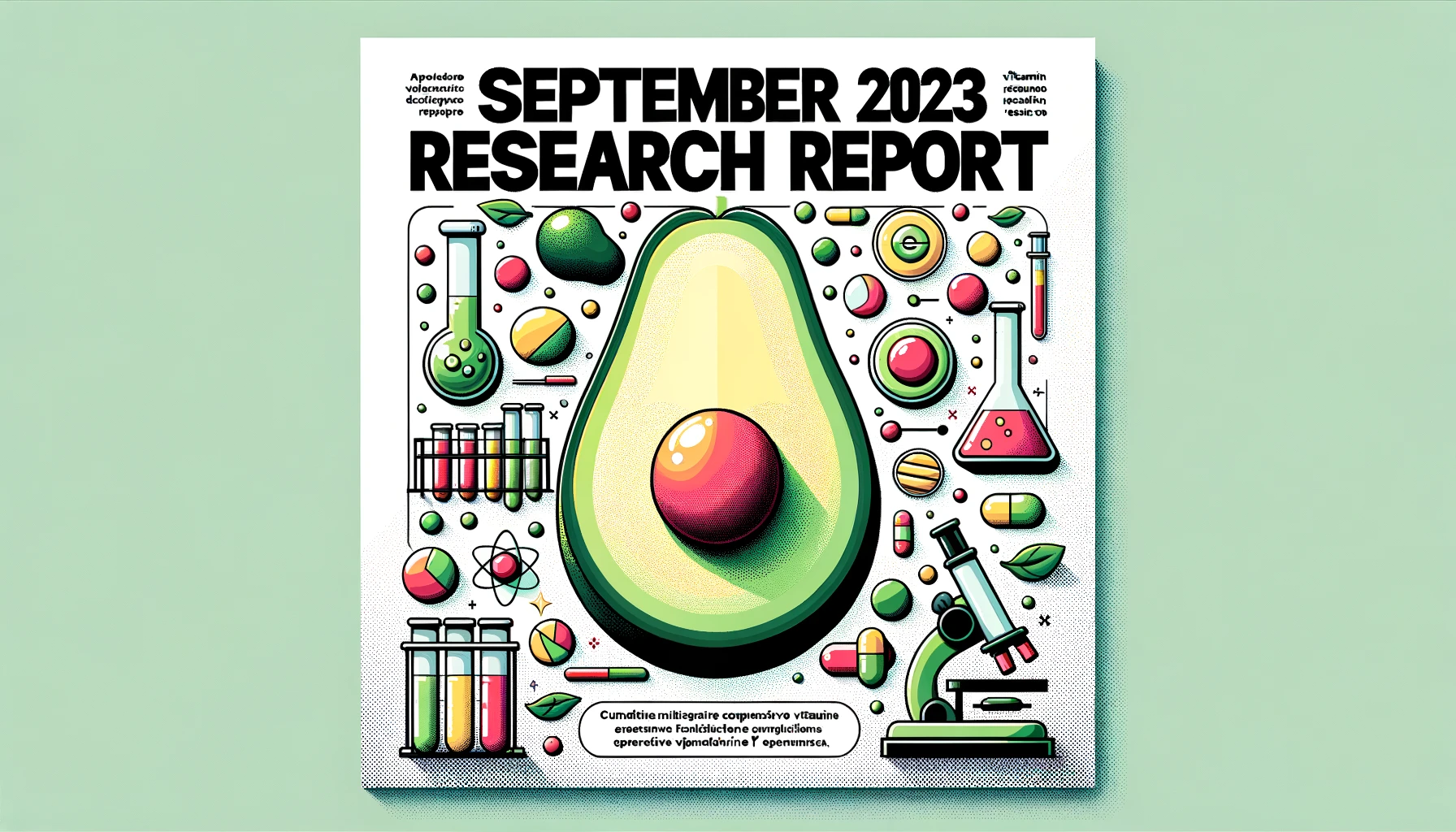Vitamin E Research: Top 5 Discoveries in September 2023

In recent years, many breakthroughs have been discovered in the field of Vitamin E research. By reviewing the latest research articles, we can see the varying impacts of Vitamin E on our body, the environment, and its relation to our everyday food items. This post provides a breakdown of these findings.
1. In Silky Fowl Meat
A study found that Silky Fowl Meat is rich in Vitamin E, which contributes to its nutritional and pharmacological benefits.
Vitamin E and Its Significant Influence in Silky Fowl Meat [1]
The flavorful Silky Fowl Meat (SFM) has more to offer than just its taste. A recent study shows that this prized breed of chicken is not only endowed with a unique surplus of essential amino acids (proteins) but is also rich in Vitamin E, implying numerous nutritional and pharmacological benefits. For comparison, standard chicken meats such as Leghorn were analyzed side by side. Findings revealed that SFM stood out in terms of varying proteins and genes, as well as other metabolites - substances necessary for metabolism. Interestingly, genes associated with making melanin were also up-regulated, potentially contributing to SFM's distinctive appearance.
But what makes SFM potentially healthier than other meats? The study uniquely uncovered factors that enhance flavors, like glutathione, glycine, and serine, being more prominent in SFM.
Most notably, however, the SFM contained significant metabolites alongside genes related to vitamin E metabolism standing out markedly. For those not in the know, Vitamin E is a well-appreciated antioxidant in nutrition science, credited with protective benefits against diseases like heart disease and cancer. This essential nutrient's presence in SFM paints a promising picture for the meat's nutritional value, as well as potential pharmacological applications. In other words, consuming SFM could arguably offer more health benefits, courtesy of this newfound richness in Vitamin E.
Equal parts delicious and nutritious, SFM's newly discovered Vitamin E component largely redefines our understanding of this revered breed of meat. This nutritional edge introduces wider implications for SFM, particularly in dietary considerations given its unique meat composition.
Much as there's more to explore, this study provides a comprehensive springboard for future investigations establishing silky fowl's place in both our kitchens and pharmacies. It's heartening proof that sometimes, what tastes good can truly be good for you, thanks to the power of Vitamin E.
2. On Radiation Necrosis
Research indicates that Vitamin E, alongside pentoxifylline, can help in the treatment of Radiation Necrosis. It may also reduce instances of lung damage, specifically in lung cancer patients.
Vitamin E and Pentoxifylline Aid to Treat Radiation Necrosis [2]
Exciting new research shows that Vitamin E, in combination with the drug pentoxifylline, has shown promise in effectively treating Radiation Necrosis (RN). RN is a common long-term side effect of radiation therapy that can plague survivors with further complications, sometimes requiring additional surgery. Thankfully, such situations could be avoided by the early use of Vitamin E, which emerged as effective in treating RN. The research, carried out using laboratory rats, displayed that the routine employment of Vitamin E considerably decreased the intensity of hypoxia-inducible factor 1α, a protein that can contribute to tumor growth and spread, among other detrimental health outcomes caused by RN. Interestingly, while Vitamin E alone or in combination with pentoxifylline proved to be effective in treating RN, their preventive use did not particularly outshine the therapeutic usage.
Vitamin E Mitigates Lung Damage in Lung Cancer Patients [3]
Meanwhile, the administration of Vitamin E, alongside pentoxifylline again, could potentially help to decrease the occurrence of lung damage – specifically radiation-induced pneumonitis – in patients with non-small cell lung cancer (NSCLC). Pneumonitis is a severe side effect of lung cancer radiation therapy, and its risk only increases in patients undergoing retreatment for recurring cancers. Early results from this ground-breaking study suggest that Vitamin E and pentoxifylline usage could substantially decrease the likelihood of patients developing grade 3 pneumonitis, a severe version of this side effect. The rate of grade 3 pneumonitis in patients treated with these two elements was reported to be significantly less than those without the treatment. Thus, Vitamin E and pentoxifylline could become critical in the safe retreatment setting for recurrent NSCLC.
3. With Other Food Ingredients
The interaction of Vitamin E and lipid compounds in food lected can significantly affect the nutritional functionalities of these items. These interactions impact properties like solubility and the antioxidant abilities of Vitamin E.
Vitamin E and Lipids Interact to Improve Antioxidant Functions [4]
Vitamin E, in the form of (±)-α-tocopherol, is typically found in lipid-rich foods like oils and fats. These essential food ingredients interact with each other – an interaction that can affect the storage and consumption properties of such foods. These interactions play a particularly important role in how vitamin E’s antioxidant abilities, as well as its solubility, function in our bodies.
In a recent study, the interplay between (±)-α-tocopherol and lipid compounds, specifically triacylglycerols (TAG) - substances that help determine the physical characteristics of oils and fats during storage and consumption, were investigated. The aim was to determine the solid-liquid equilibrium of these binary mixtures and to describe their phase diagrams fully.
The study found that the introduction of (±)-α-tocopherol resulted in a notable decrease in the melting temperature of TAG. This suggests that there is a high affinity between these two molecules, with thermodynamic modeling validating this by showing deviations less than 2%. The formation of solid solutions was also inferred from the microscopic and X-Ray diffraction data.
These research findings are particularly significant for both food and pharmaceutical industries. As vitamin E is prone to high affinity with lipid molecules, this interaction can possibly mitigate phase separation in food in both solid and liquid phases. Its antioxidant function might thus be enhanced in lipid-based systems, which can significantly affect the nutritional functionality of such foods.
Understanding these interactions between food compounds could offer avenues for improving the nutritional functionalities of food products, especially those rich in oils and fats. Moreover, it illuminates how we can better harness the incredible antioxidant abilities of Vitamin E in our food systems, contributing to healthier diets and lifestyles.
4. In Anxiety Management
Vitamin E appears to manifest anxiolytic effects and can help in minimizing brain lipid peroxidation during aging. It's often contributed to the prevention or management of anxiety.
Vitamin E in Cactus Flour Eases Anxiety and Reduces Brain Lipid Aging in Rats [5]
A fascinating study reveals that cactus flour, rich in antioxidants and Vitamin E, can help minimize anxiety-like behavior and lower rates of brain lipid peroxidation in older rats. Researchers divided the rats into groups and varied their diet - a control group received a standard diet, and other groups received a similar diet with the addition of 5%, 10%, and 15% of cactus flour respectively. Throughout the experiment, they closely monitored behavioral patterns of each group.
They found that the groups with cactus flour in the diet performed better in a collection of tests designed to measure anxiety-like behaviors. In one test, called an elevated plus maze, rats fed with diets comprising 5%, 10%, and 15% cactus flour spent more time in the open arms, hinting at lower anxiety levels, with the group consuming 15% cactus flour exhibiting the most significant improvement. Similarly, these groups displayed more significant exploration in an open-field test, indicating lesser anxiety.
The researchers also noticed a decrease in brain lipid peroxidation, a damaging process linked to brain aging, in the groups that consumed cactus flour. This discovery suggests that the use of cactus flour, and possibly the rich concentration of mono and polyunsaturated fatty acids, soluble fibers, and antioxidant contents such as vitamin E and selenium it carries, could aid in slowing brain aging and preventing or reducing anxiety. It’s a promising step towards understanding the potential benefits of Vitamin E and the effects of diet on anxiety management and brain health.
5. In Lupin Seeds
Data suggests that the germination of lupin seeds can significantly modify the tocopherol content, particularly α-tocopherol. The resultant increase in Vitamin E activity makes lupin seeds nutritionally advantageous.
Germination boosts Vitamin E in Lupin Seeds [6]
One exciting research study delved into understanding how the controlled germination of the Andean lupin seeds could potentially affect their color, carotenoids, and tocopherols. Two distinct ecotypes, Cholo fuerte and Altagracia, underwent germination in the dark for varying time periods - two, four, and six days. The researchers measured the color coordinates using a colorimeter, while employing HPLC (High-Performance Liquid Chromatography) to quantify the carotenoids and tocopherols.
The study revealed that the germination process significantly altered these characteristics. As the germination time increased, the luminosity (brightness) of the seeds decreased. Interestingly, the total carotenoids amplified up to twelve times during germination, with lutein emerging as the most abundant compound consistently.
The most prevalent tocol was γ-tocopherol; however, the total tocol content remained fairly constant. All the more, the process astonishingly heightened the α-tocopherol levels from non-quantifiable to a whopping 74.8 mg/kg dry matter. This substantial rise in α-tocopherol levels directly translates to an increase in the Vitamin E activity. Conversely, γ-tocopherol levels lowered progressively.
The study concludes that germination can be an affordable strategy to enrich the nutritional value of lupin seeds, featuring a significant boost in Vitamin E. This research holds promise for those seeking nutrient-dense food alternatives, thus making a compelling case for including germinated lupin seeds in our daily diet.
Conclusion
Vitamin E research has illuminated its versatility and fundamental role in numerous health-related aspects, ranging from meat production to radiation therapy. As we understand more about vitamin E, we can better leverage it for nutritional and medicinal applications. It's indispensable for us to continue researching how to maximize its potential benefits.
References
Hu, Y., Dang, M., Isah, M. B., Yakhkeshi, S., Chen, C., & Zhang, X. (2023). Comparative analysis of muscle profiles in silky fowl and white Leghorn Chicken: Insights from multi-omics and experimental approaches. LWT, 187, 115364. https://doi.org/https://doi.org/10.1016/j.lwt.2023.115364
Otluoglu, G. D., Yılmaz, B., Ekinci, G., Bayri, Y., Bozkurt, S. U., & Dağçınar, A. (2023). Pentoxifylline and Vitamin E Can Restrict Radiation Necrosis via Vascular Pathways, Experimental Study in an Animal Model. World Neurosurgery. https://doi.org/https://doi.org/10.1016/j.wneu.2023.08.135
Willett, A., Silverman, C. L., Woo, S. Y., Gaskins, J., & Dunlap, N. E. (2023). Pentoxifylline and Vitamin E in Preventing Pneumonitis Using Stereotactic Ablative Radiotherapy in Previously Irradiated Patients. International Journal of Radiation OncologyBiologyPhysics, 117(2, Supplement), e74. https://doi.org/https://doi.org/10.1016/j.ijrobp.2023.06.810
Andrade, S. S., Ferreira, R. S. B., Farias, F. O., de P. Soares, R., Costa, M. C., Corbi, P. P., Meirelles, A. J. A., Batista, E. A. C., & Maximo, G. J. (2023). Solid-liquid equilibria of triacylglycerols and vitamin E mixtures. Food Research International, 173, 113440. https://doi.org/https://doi.org/10.1016/j.foodres.2023.113440
de Lima Moura, R., Dutra, L. M. G., da Vitória Santos do Nascimento, M., de Oliveira, J. C. N., Viera, V. B., Dantas, B. S., Costa, R. G., da Silva, M. S., de Medeiros, A. N., do Nascimento, Y. M., Tavares, J. F., & Soares, J. K. B. (2023). Cactus flour (Opuntia ficus-indica) reduces brain lipid peroxidation and anxious-like behavior in old Wistar rats. Physiology & Behavior, 272, 114360. https://doi.org/https://doi.org/10.1016/j.physbeh.2023.114360
Estivi, L., Pascual Chagman, G. J., Santa Cruz Olivos, J. E., Savasi, P., Brandolini, A., & Hidalgo, A. (2023). Changes in colour, tocopherols and carotenoids during the germination of lupin seeds. Journal of Food Composition and Analysis, 124, 105682. https://doi.org/https://doi.org/10.1016/j.jfca.2023.105682
